
Shantanu Prakash
King George’s Medical University, India
Title: Issues in laboratory diagnosis of acute encephalitis syndrome
Biography
Biography: Shantanu Prakash
Abstract
Statement of the Problem: Acute encephalitis syndrome is a group of neurologic manifestations caused by a plethora of organisms including viruses, bacteria, fungi, parasites and toxins. There is a large amount of cross reactivity between the different etiological agents. Also, besides Japanese Encephalitis Virus, no guidelines exist for establishing the diagnosis of specific etiologic agents. This session deals with the methods available, practical problems, their advantages and disadvantages for laboratory testing of agents of AES.
Methodology & Theoretical Orientation: An extensive literature search was done to summarize a comprehensive approach for the laboratory investigations in the diagnosis of AES.
Findings: Laboratory diagnosis is generally established by testing the serum or CSF sample to detect virus specific IgM antibodies. IgM antibodies are usually detectable 3 to 8 days after onset of illness and persist usually for 30 to 90 days. Therefore, positive IgM antibodies may reflect a past infection or vaccination. Sample collected within 10 days of illness onset may not have detectable antibodies and so Real Time PCR and antibody testing on a convalescent sample becomes important. For patients with IgM antibodies, confirmatory neutralizing antibody testing should be performed. In fatal cases, nucleic acid amplification, histopathology with immunohistochemistry, virus culture of autopsy tissues can also be useful.
Conclusion & Significance: The choice of test depends upon the prevalent etiological agent in a geographical region, patient’s post-illness day of presentation to the health care centre, sample available and diagnostic facilities available. A laboratory network should be established for better patient management and optimum utilization of resources.




